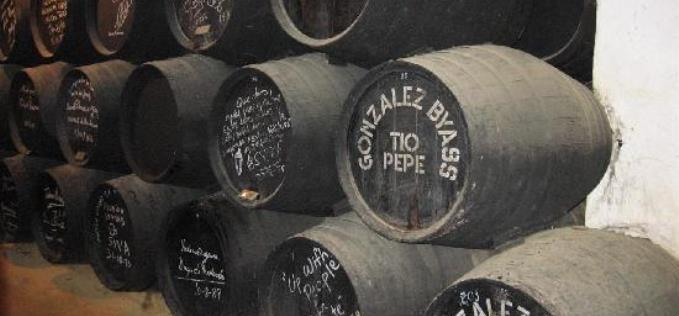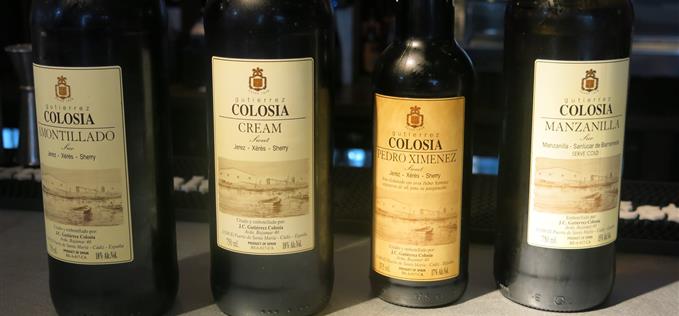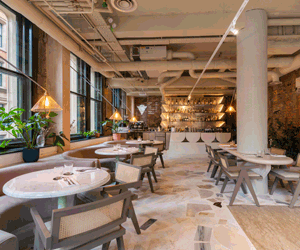HAWKSMOOR private dining room. It might be the boardroom of some sherry bodega in Jerez. In its dark panelled intimacy, Beltran Domecq contemplatively sips an ‘En Rama’ style Manzanilla before lunch. Our rib-eye we will be served with its darker siblings, Palo Cortado and Amontillado.
The British, sherry’s most loyal customers, consume only half the stuff we did in the Seventies
Later, the globetrotting sherry ambassador will lead masterclasses at Hangingditch wine merchants further down Deansgate. But for now, it’s all about the saline pungency of the En Rama, a bold, unfiltered innovation in an Andalucian wine industry dedicated to tradition.
We, the British, sherry’s most loyal customers, consume only half the stuff we did in the Seventies, 60 percent still being ‘cream’ styles. The Amontillados, Olorosos and Palo Cortados are a niche market despite much marketing and their promotion in our burgeoning Spanish restaurant trade. The fact I include a style primer below says it all. But back to En Rama. Rama means 'branch', so this is literally ‘raw’ sherry.
What is it, Beltran?
“In theory, it’s a Fino that has not been touched from the solera (barrel) to the bottle, but it’s not quite like that. If you put a bottle in the fridge it might go hazy and people don’t like hazy. There has to be an amount of manipulation but that is kept to a minimum.
“In Spain, 84 percent of sherry consumption is Manzanilla and Fino, but they expect it to be very pale and light in taste. That is why En Rama doesn’t move much over there. It has more colour because the body, structure and taste are much more powerful. The average English person has been drinking sherry that has been bottled for a long time and is darker. So the colour of this very fresh wine doesn’t bother them.
“Small producers started doing En Rama first and then eight years ago Gonzalez Byass took it on for their Tio Pepe and it has done very well. So have their Palmas (limited edition Fino bottlings). I think we have to diversify and get more exciting things into the market.”
 Sherry ambassador, Beltran Domecq
Sherry ambassador, Beltran DomecqYou have been in the industry many years. Has the quality improved?
“Most certainly. If you buy a bottle of white wine at the table you expect to drink it at the same moment. If you take a bottle of Fino, we say if you open it and keep it in the fridge, you will be able to drink it for the next five/seven days – its style gives it a more stable existence. Technology has done a lot in the last 30 years in keeping stability. We bottled in a nitrogen atmosphere. We bought machines to measure the oxygen content of wines and their evolution. We went onto metal closures but marketing people said No we want cork. so we went back."
I’m confused by what I’m getting in styles such as Amontillado and Oloroso. Sweet or dry? It’s hard to gauge.
“That is a continuing problem with true Olorosos and Amontillados because regulations didn’t permit them to have more than 5gm of litre of sugar. Otherwise, they had to say ‘Medium Sherry made with Amontillado or Oloroso’. It was and is confusing for the public."
You are keen to promote the merits of sherry with food. It is not many people’s perception of these wines...
“Take Hawksmoor’s lovely smoked salmon, our starter today. The Manzanilla L Goya and the Harvey’s Fino are perfect partners. Similarly, the Cream Diez Merito and the Pedro Ximenez, Bodegas Tradition.
"I remain to be convinced about the Palo Cortado, Fernando de Castilla (one of my favourite sherries) or the acclaimed Amontillado from Bodegas Urium as companions for the steak, although they did handle with aplomb the potent Stilton and anchovy hollandaise accompaniments."
Beltran Domecq, now 70, descends from a long line of sherry and brandy producers. A trained chemist and oenologist, he has worked for the Williams & Humbert Bodegas and Domecq Bodegas, Pedro Domecq SA. As president of the Consejo Regulador of Jerez, sherry’s governing body, he travels tirelessly to promote the wines.
 Tio Pepe
Tio Pepe
Sowerby's top sherry recommendations:
The imminent International Sherry Week (November 7-13) with a flurry of events will allow you to explore this most fascinating of wine cultures. My own gut feeling is that sherry’s mainstream future lies with the fresh, zingy, lower in alcohol, food-friendly Manzanillas and Finos. You pay a premium for the new release En Ramas, but they are very much in tune with the market for ‘Natural Wines’. The one we drank is I Think from Equipo Navazos, is on the shelves at city centre restaurant bar El Gato Negro Tapas at £6 per 75ml glass or £28 per 375ml bottle. You can buy it retail, too, at The Vineyard wine shop in Ramsbottom at just over £11 for 37.5cl.
The Vineyard also stock the gorgeous Colosia sherries from Bodegas Gutierrez. You’ll find a full range of these at the Tapeo and Wine restaurant on Deansgate, Manchester. Try the Colisia Amontillado which smells of salted caramel, dried apricots and nuts and is tangy toffee and citrus on the palate.
The aforementioned hangingditch alongside the Cathedral offers a wealth of sherries. Head honcho Ben Stephenson’s favourite is El Maestro Sierra Fino (£12.50, 75cl to take away). Deliciously dry, nutty yet floral, tangy, complex, fabulously long and multilayered. from one of the oldest and most traditional bodegas in Jerez.
Just along Deansgate at restaurant/bar/deli Lunya, head bartender Liv Kilner recommends Leonor Palo Cortado (£17.80) by Gonzales Byass with its lovely, nutty flavour neither too sweet or too dry. She is also a fan of the Tio Pepe En Rama (£11.05, 37.5cl, £17.65 75ml) – it smells salty, yeasty even slightly smoky, fresh and savoury in the same glass. These are deli prices from an amazing sherry list but the bar itself also offers flights of various styles – a perfect introduction.
Evuna, with its two outlets on Deansgate and the Northern Quarter, is a bastion of Spanish wine in the city. You can drink in or take away. Owner Jane Dowler’s recommended sherries are from Fernando de Castilla – both the Antique and Classic ranges. The bodega is based in sherry epicentre Jerez but run by genial Norwegian Jan Pettersen, a frequent visitor to Manchester. Jane says: “My food and wine match recommendation would be Antique Amontillado, over 20 years old and only bottled once a year during wine. Pair it with peppered duck breast seared with a balsamic reduction.”
Evuna, Lunya, Tapeo and El Gato Negro are joined by Iberica, La Bandera and El Rincon in Manchester Food and Drink Festival’s The Spanish Trail guided tapas walks on Wednesday, October 5 and Thursday, October 6. Sherry may be involved. Full details here.
 Tapeo's gorgeous Colosia sherries
Tapeo's gorgeous Colosia sherries
Confused by sherry styles? Well no more...
Fino Crisp, yeasty, nutty and tangy, the freshest and most delicate of sherry styles, at around 15% alcohol. Protected from oxygen during its development by a yeast ‘blanket’ called flor, fino, it needs to be treated like white wine once it has been opened. Chill.
Manzanilla A Fino style from the atmospheric coastal town of Sanlúcar de Barrameda. The flor’s thicker here, so the wines are lighter with a salty tang.
Amontillado Amber coloured aged Fino that has lost its flor and gone on to develop through oxidation a nutty complexity and length. Fortified to £17.5% to protect its development it lasts longer once opened.
Palo Cortado A half way house between a fino and an amontillado, Palo Cortado is the result of a Fino sherry mysteriously losing its flor. Nutty and complex, but fresher
Oloroso These develop in barrel without the protective flor layer, often for many years. Result is a deep mahogany, dry, nutty sherry with scents of old furniture and raisins.
Pedro Ximénez Ultra-sweet liquid Christmas cake, crafted from air-dried grapes, with fermentation stopped early by the addition of spirit, Pedro Ximénez is in vogue, possibly because it’s good poured over vanilla ice cream.
Cream Cream sherries are more commercial products that have been sweetened by the addition of Moscatel or Pedro Ximénez grapes.
Follow @AntonEgoManc for more wine warblings
 Powered by Wakelet
Powered by Wakelet















